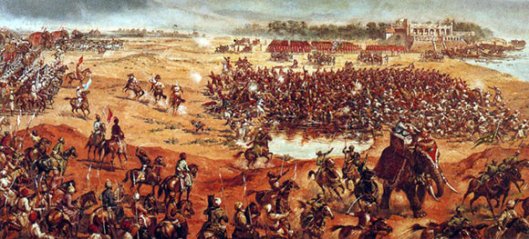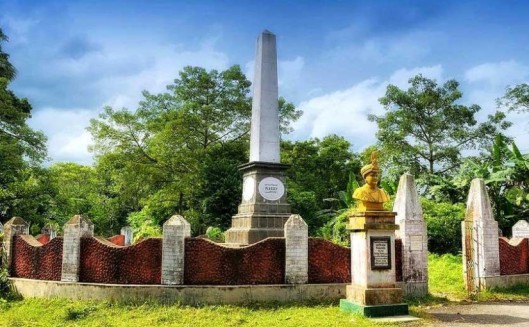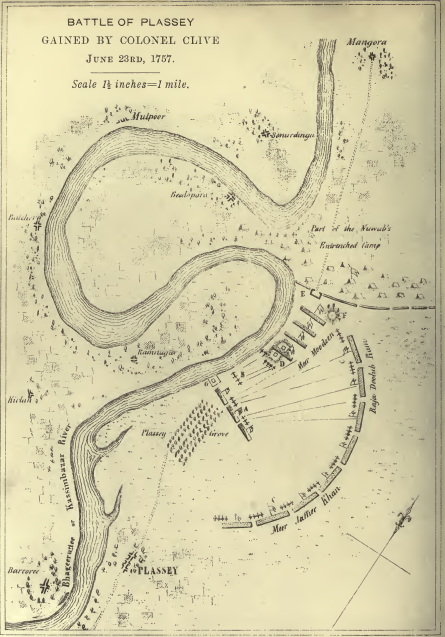Palashi in present day West Bengal is a small town which derives its name from Polash– the Bengali name for the red flower, popularly known as flame of the forest- which once abounded in that region. Anglicised as Plassey, that obscure little town was the scene of a seemingly insignificant battle, but one whose outcome changed the course of India’s history. The effects of that battle are felt to this day.
This is the story of how it happened.
Bengal in 1757
The re-conquest of Calcutta in February 1757 followed by the humiliating treaty that the British imposed on Siraj ud Daula, the nawab of Bengal, greatly diminished the prestige of the already unpopular nawab while proportionately increasing the fear and awe in which the British were held.
Lieutenant Colonel Robert Clive, member of the governing council at Calcutta, followed up the victory against the nawab’s army by raiding the French settlement in Chandan Nagar and, in effect, rendering the French incapable of ever challenging British arms in India.
An Uneasy Peace
Mir Jafar- grand uncle of Siraj ud Daula and one of the most influential people in the kingdom- had ample reason to dislike the nawab, as we have seen earlier. Siraj, with his increasingly fickle behaviour after the humiliation at the hands of the British in February 1757 left courtiers- especially Mir Jafar- even more fearful of his caprices.
The British, who already had designs on the nawab, sought to exploit the prevailing atmosphere of fear and suspicion. On the instructions of Clive, William Watts- the British waqeel (representative) at the nawab’s court- started cultivating a friendly relationship with Mir Jafar.
The British were hardly alone in the game of conspiracies. Siraj, who had blown hot and blown cold after the humiliation of February, had taken umbrage when Clive had dispatched a detachment of troops to pursue French soldiers and officials, who had escaped during the siege of Chandan Nagar and taken refuge in Bihar. He angrily served an ultimatum to Watts on 20th April instructing the British not to disturb the French any further or else end all diplomatic relations and recall their waqeel to Calcutta.
The British did neither, much to the chagrin of Siraj. The desire to get rid of the other was intense and mutual. It was just a matter of time before things would come to a head.
Conspiracy in the Air
On 23rd April 1757, the British received a proposal from an officer named Yar Lutf Khan to overthrew the nawab with his support and name him as the new nawab. In exchange he offered to enter into any engagements which the English should stipulate for the advantage of their affairs. He was almost certainly acting on behalf of the Seths, a family of prosperous traders whose backing had propelled Alivardi Khan- the previous nawab- to the throne.
The Seths had been sidelined by Siraj, losing the position of influence they had enjoyed under his grandfather. If that was not bad enough, Siraj’s increasingly capricious and insecure behaviour gave them every reason to fear that he could at any time turn against anyone who could possibly hurt him. To make things worse, they had sustained a massive loss when the French- to whom they had lent large sums of money- had been driven out by the British. Siraj had done nothing to help them recover their losses.
The British, consequent to the ultimatum served on them by Siraj, were already contemplating overthrowing him. They now had the backing of the Seths who, strangely enough, had not definitely named the would-be successor to Siraj. The very next day came a communication from Khwaja Petrus, an Armenian merchant close to the nawab. This one came from a much higher source.

The Battle of Plassey
Mir Jafar, who had every reason to hate and fear Siraj, had sent a proposal through Petrus to dethrone the nawab. Not only did he offer wholehearted support, but he also named several high ranking officials who were part of the conspiracy. He called upon the company to suggest their terms. For good measure, he also advised soothing the nawab’s fraying nerves with every appearance of peace until the preparations were complete.
The British were already weighing similar offers from other quarters. The sheer seniority of Mir Jafar left little doubt as to who would be their most valuable ally. They lost little time in proposing their terms, which included:
- Mir Jafar to confirm all the grants and privileges allowed by Siraj ud Daula to the company
- Mir Jafar to enter into an offensive and defensive alliance with the British.
- All Frenchmen in Bengal with their Factories and goods to be delivered up to the British. The French never to be permitted to resettle in the three Provinces (Bengal, Bihar and Orrisa).
- East India Company to receive 100 lakhs tor the loss sustained by the destruction of Calcutta and for the expenses of the war.
- The Company to receive the zamindari of the country south of Calcutta between the River and the Salt Lakes as far as Culpee.
Mir Jafar did not give an immediate reply as he had to first consult Rai Durlabh, the nawab’s treasurer who commanded most of the army. A conspiracy to overthrow the nawab would be futile without the support of the treasurer. On 4th June 1757, William Watts was informed that Rai Durlabh and Mir Jafar had agreed to the terms of the committee.
Deadly Games
The plan now firmly in place, William Watson started planning his escape from the clutches of Siraj. On 12th June he and two companions, under the pretext of going out to the countryside on a hunt, made their escape and joined Clive and his forces, who were camped at Khulna (in present day Bangladesh).

Plassey War Memorial
In the meanwhile, Siraj ud Daula, who had received information of the brewing conspiracy from the French, sprung into action. Knowing how badly he needed the support of his senior officers, he personally called on Mir Jafar and sought reconciliation. Jafar, who had no reason to trust the young man, promised to be true to the nawab, even as he was sharpening the knives.
Siraj, satisfied that he had the support of his grand uncle, now set out to carry out his long held desire to get rid of the British. He joined his troops who were camped in a place called Palasi (Anglicised as Plassey). On 23rd June, the two armies came face to face- the nawab’s army far outnumbering the forces of the East India Company. On paper it should have been a no-contest.
Unknown to him, the nawab was in for a nasty surprise.
The Battle of Plassey
On the morning of 23rd June, Siraj ud Daula took his head at the vanguard of a 15,000 strong force. Supporting the vanguard were the forces of Mir Jafar, Rai Durlabh and Yar Lutf Khan, all three of whom were in the conspiracy. Not a shot would be fired by their troops.
Another factor which favoured the British was the fact that they were protected from cannon fire by the Laksha Bag– a grove of 100,000 trees which they had occupied. The only effective alternative was hand to hand combat which, given the forested terrain, would have entailed severe casualties. Whether it was to avoid unnecessary casualties or due to the uncertain morale of his troops, Siraj desisted from ordering an all-out assault on the British.
An indecisive cannonade lasted several hours until a heavy shower in the afternoon damaged the gunpowder, resulting in a slackening of fire from the nawab’s side. Sensing an opening, Major Killpatrick unilaterally launched an assault- sending word to Robert Clive, who was temporarily away from action to get some much needed rest, having given instructions not to go on the offensive until night time. Clive was at first dismayed when he received the intimation. His first instinct was to instruct Killpatrick to retake position. However, soon realising that it was impossible to do so, he reversed his orders.

By then morale in the nawab’s camp was at rock bottom. No one quite knew who was fighting and who was not. Worse still, Siraj’s army had lost Mir Madan, one of the most senior officers. The confusion plus the damage to the gunpowder had completely sapped the morale of the nawab’s forces, who fell apart amidst scenes of utter chaos.
Realising that the war was lost, Siraj ud Daula hastily retreated from the battle field. Clive and Killpatrick had won the day.
Aftermath
- Siraj ud Daula headed off to Bhagwangola (in present day Murshidabad district of West Bengal) in disguise. By a cruel twist of fate, he was recognised by an enemy who happened to be present purely by coincidence, who had him arrested.
- Mir Jafar was crowned the new nawab. He would be dismissed by the company in 1760, before being reinstated in July 1763. He remained in power until his death in January 1765, aged 73
- An estimated £ 4.5 million was paid by Mir Jafar to the East India Company and to private individuals who had sustained losses due to the sacking of Calcutta in June 1756
- Siraj ud Daula was murdered in captivity on 2nd July 1757
Legacy
- The victory effectively rendered the British the masters of a vast territory, bigger than any European country
- The victory at Plassey, following a similar success in the south a few years earlier, laid the foundation of the British empire in India
- The defeat of the French at Chandan Nagar, followed by the final defeat at Vandivasai (Wandiwash) in 1760 ensured that the British would have no rivals for power in India
- The name Mir Jafar remains, to this day, a byword for a traitor in eastern India
Sources
- Robert Orme, A History of the Military Transactions of the British Nation in Indostan from the year 1745, Volume II, The Strand, London (1813)
- S.C. Hill, Bengal in 1756-57, John Murray, London (1905)

beautifully penned and really piques interest about one of the biggest game changers in Indian history
Thanks a tonne mate! Actually the Battle of Buxar in 1765 was even more significant that the battle of Plassey- I’ll write an article on that some day in the future